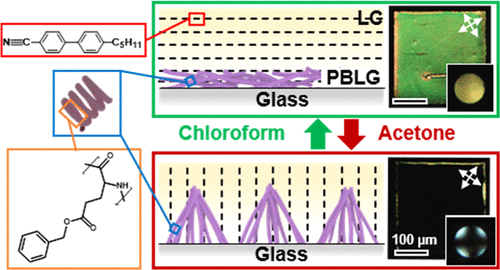当前位置:
X-MOL 学术
›
Macromolecules
›
论文详情
Our official English website, www.x-mol.net, welcomes your feedback! (Note: you will need to create a separate account there.)
Using Liquid Crystals to Probe the Organization of Helical Polypeptide Brushes Induced by Solvent Pretreatment
Macromolecules ( IF 5.5 ) Pub Date : 2021-08-30 , DOI: 10.1021/acs.macromol.1c01125 Michael Tsuei 1 , Hai Tran 1 , Sangchul Roh 1 , Christopher K. Ober 2 , Nicholas L. Abbott 1
Macromolecules ( IF 5.5 ) Pub Date : 2021-08-30 , DOI: 10.1021/acs.macromol.1c01125 Michael Tsuei 1 , Hai Tran 1 , Sangchul Roh 1 , Christopher K. Ober 2 , Nicholas L. Abbott 1
Affiliation

|
Grafted polymer brushes form the basis of a versatile class of surfaces with properties that can be tailored via choice of the chemical functional groups or architecture of the grafted polymers. Here, we explore how treatment by solvents can program the organization of homopolymer brushes comprising helical poly(γ-benzyl-l-glutamate) (PBLG) and how the orientational behavior of liquid crystals (LCs) contacted with the brushes can provide fresh insights into brush organization. We treated PBLG brushes with either good (chloroform) or poor (acetone) solvents to form collapsed or teepee-like grafted polymer organizations, respectively. When supported on PBLG brushes with thicknesses [determined by atomic force microscopy (AFM)] of 50 nm, we found that collapsed and teepee-like brushes induced planar (parallel to surface) and homeotropic (perpendicular to surface) orientations of nematic LCs, respectively. By preparing solvent-pretreated brushes with a range of thicknesses (12–140 nm), and by combining insights based on AFM, Fourier-transform infrared spectroscopy and LCs, we found that a continuous change in tilt of the LC is accompanied by a continuous change in tilt of the PBLG chains, as influenced by the teepee-like organization. The role of PBLG chain orientation in dictating the LC orientation was confirmed by additional experiments in which PBLG brushes were thermally denatured. Finally, when using mixed solvents (mixtures of chloroform and acetone) to manipulate the PBLG brush organization, we observed LCs to exhibit patterned orientations on the micrometer scale, consistent with patterned orientations of the PBLG chains imprinted by droplets formed during the mixed solvent drying process. Overall, these results expand our understanding of the range of PBLG brush organizations that can be induced by solvent pretreatment and demonstrate the utility of LCs for imaging PBLG chain orientation within brushes.
中文翻译:

用液晶探测溶剂预处理诱导的螺旋多肽刷的组织
接枝聚合物刷子构成了多功能表面的基础,其特性可以通过选择接枝聚合物的化学官能团或结构来定制。在这里,我们探讨了溶剂处理如何对包含螺旋聚(γ-苄基-l)的均聚物刷的组织进行编程-谷氨酸) (PBLG) 以及与刷子接触的液晶 (LC) 的取向行为如何为刷子组织提供新的见解。我们用好的(氯仿)或差的(丙酮)溶剂处理 PBLG 刷子,分别形成塌陷或类似圆锥形的接枝聚合物组织。当支持厚度为 50 nm [由原子力显微镜 (AFM) 确定] 的 PBLG 刷子时,我们发现塌陷和类似圆锥形的刷子分别诱导了向列型 LC 的平面(平行于表面)和垂直(垂直于表面)取向. 通过制备一系列厚度(12-140 nm)的溶剂预处理刷,并结合基于 AFM、傅里叶变换红外光谱和 LC 的见解,我们发现 LC 倾斜度的连续变化伴随着 PBLG 链倾斜度的连续变化,受类似帐篷的组织的影响。PBLG 链方向在决定 LC 方向中的作用通过额外的实验证实,其中 PBLG 刷子是热变性的。最后,当使用混合溶剂(氯仿和丙酮的混合物)来操纵 PBLG 刷组织时,我们观察到 LC 显示出微米级的图案取向,与混合溶剂干燥过程中形成的液滴印记的 PBLG 链的图案取向一致. 总体而言,这些结果扩展了我们对溶剂预处理可诱导的 PBLG 刷组织范围的理解,并证明了 LC 对刷内 PBLG 链方向成像的效用。
更新日期:2021-09-14
中文翻译:

用液晶探测溶剂预处理诱导的螺旋多肽刷的组织
接枝聚合物刷子构成了多功能表面的基础,其特性可以通过选择接枝聚合物的化学官能团或结构来定制。在这里,我们探讨了溶剂处理如何对包含螺旋聚(γ-苄基-l)的均聚物刷的组织进行编程-谷氨酸) (PBLG) 以及与刷子接触的液晶 (LC) 的取向行为如何为刷子组织提供新的见解。我们用好的(氯仿)或差的(丙酮)溶剂处理 PBLG 刷子,分别形成塌陷或类似圆锥形的接枝聚合物组织。当支持厚度为 50 nm [由原子力显微镜 (AFM) 确定] 的 PBLG 刷子时,我们发现塌陷和类似圆锥形的刷子分别诱导了向列型 LC 的平面(平行于表面)和垂直(垂直于表面)取向. 通过制备一系列厚度(12-140 nm)的溶剂预处理刷,并结合基于 AFM、傅里叶变换红外光谱和 LC 的见解,我们发现 LC 倾斜度的连续变化伴随着 PBLG 链倾斜度的连续变化,受类似帐篷的组织的影响。PBLG 链方向在决定 LC 方向中的作用通过额外的实验证实,其中 PBLG 刷子是热变性的。最后,当使用混合溶剂(氯仿和丙酮的混合物)来操纵 PBLG 刷组织时,我们观察到 LC 显示出微米级的图案取向,与混合溶剂干燥过程中形成的液滴印记的 PBLG 链的图案取向一致. 总体而言,这些结果扩展了我们对溶剂预处理可诱导的 PBLG 刷组织范围的理解,并证明了 LC 对刷内 PBLG 链方向成像的效用。



























 京公网安备 11010802027423号
京公网安备 11010802027423号